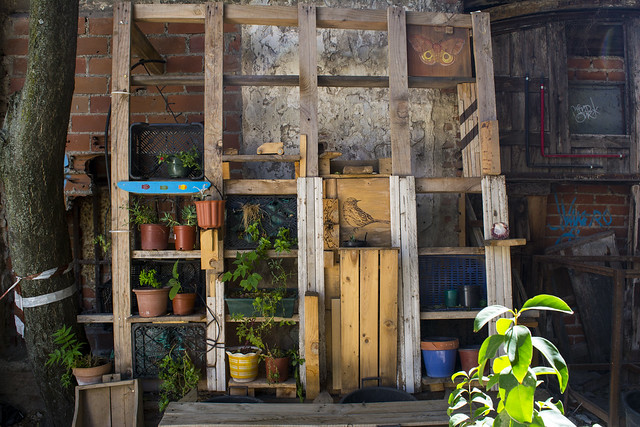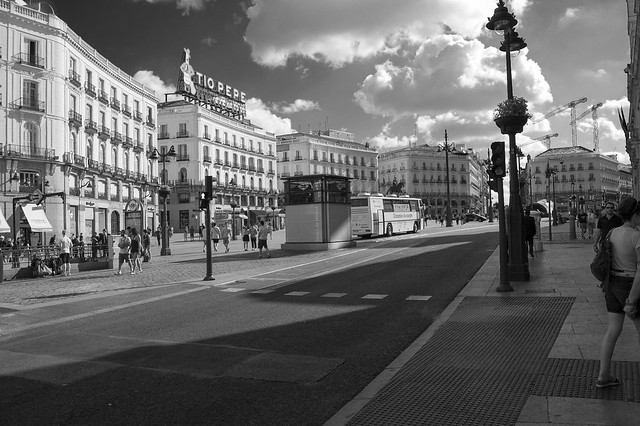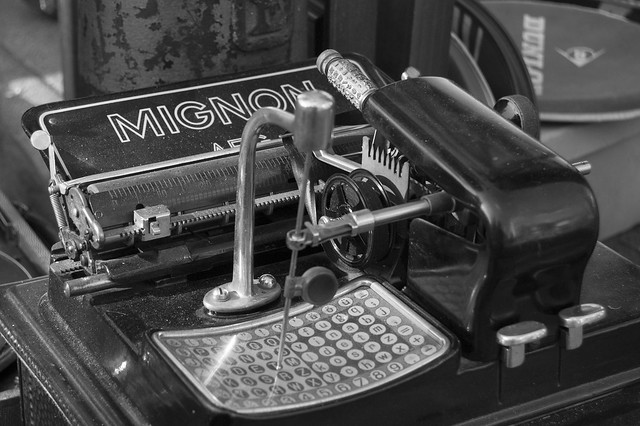Walk Around Lavapiés, Sol and El Rastro de Madrid
Tour Lavapiés, Sol and El Rastro de Madrid in a day! What could be better? You’ll get to see the city as it was meant to be seen–on foot.
And with all of these areas so close together, you can really experience the different vibes they give off. Try out an authentic tapas spot for lunch, then head down to Plaza Mayor for an afternoon cocktail at one of its many outdoor bars.
Go up to Tirso de Molina, take a walk through the Puerta del Sol and the Plaza Mayor, and end at the Rastro going down the Ribera de Curtidores until the Ronda de Toledo. From there you can go back through the ambassadors and the Ronda de Valencia.
Lavapiés, Sol, and El Rastro de Madrid are three popular tourist attractions in the city’s heart. These places will not disappoint you with many interesting things to do and see!
- Related: Must-Visit Places in Madrid
- Check out: Free Walking Tour with a Guide. The activity takes place with a guide that speaks English.
A Walk Through Lavapiés, Sol and El Rastro
It is a good walk and it is super interesting. It is worth it because it will allow you to get to know a good part of the historic center and the most typical part of Madrid.
If you like, you can read about our experience with a free walking tour in Madrid.

Lavapiés’ District
You could start at the Ronda de Atocha St, right next to the Reina Sofía museum; if you want, you can visit the museum.
Esta es una Plaza (This is a Square)
Going down towards ambassadors, you take Mallorca street, which goes up to the square in the street of Dr. Fourquet. It is a very particular square self-managed by the neighbors.
You will find an orchard, an area for children, a type of auditorium made with wooden pallets, and a tent with tables to eat, among many other things.
Honestly, I think this is a place worth knowing.
Lavapiés Square
You go down the street of Dr. Fourquet, and you’ll arrive at Valencia street, which goes up to the Plaza de Lavapiés.
One of the most curious things we learned about this neighborhood is that it was the old Jewish quarter of Madrid.
To demonstrate that they had been Christianized, the converted Jews who lived in this neighborhood baptized their children with a very Spanish common name, Manuel.
This is why this neighborhood was also known as the “Barrio de Los Manolos.”
Manolo is Manuel’s nickname (Like Harry for ppl called Henry)
Now, you are in the area known as the “castiza zone,” where they walked through its streets, the “pimps,” the “majas” or “Los Manolos.” We are in what was called the “slums” of Madrid.
Tirso de Molina and Sol
You’ll continue walking Lavapiés Street to Magdalena Street and arrive at Tirso de Molina Square.
Tirso de Molina is a place that has nothing special either. It was renewed quite a few years ago; more space was given to the pedestrian, trees were planted to provide shade, and some kioskos were installed to sell flowers.
It is not that it has any special monument or anything; it simply serves as a place that links many places in the center such as Lavapiés, El Rastro, Plaza Mayor, La Latina, or Puerta del Sol.
From the Plaza de Tirso de Molina, you’ll take the street of Doctor Cortezo, which continues on Calle Carretas, which ends at Puerta del Sol.
Carretas Street
Carretas Street was and is a very important street in Madrid. In it were the offices of the Philippine Company, the National Printing Office, and the post offices.
Most of its stores were bookstores and before this broqueleros (manufacturers of badges and shields).
It was the Café Pombo, well known in its time for being the place where the best-known social gatherings in Madrid were held and animated by the writer Ramón Gómez de la Serna.
It was also one of the first streets to have “sidewalks” next to Montera Street.
La Puerta del Sol (The door of the Sun)
You arrive at Puerta del Sol. Puerta del Sol has undergone many changes and transformations.
Between the Calle Alcalá and the Carrera de San Jerónimo, (the Apple Store), the Buen Suceso Hospital was founded in 1438 to care for plague patients.
It was demolished in the 19th century and became the Paris Hotel. However, its clock was saved, and do you know where it was put? In the tower of the Post Office!
The one you can see all the year’s ends sing the twelve bells. But it is not the original clock, it was changed in 1866 by the one we know today, and in 2016 it turned 150 years old.
This square has been the nerve center of Madrid for many years and has undergone many changes and transformations. In its beginnings, the Puerta del Sol was a “wide street.”
The Works of Puerta del Sol
In the mid-nineteenth century and with considerable controversy, it was decided to remodel the square and leave it with its current shape.
Works and improvements have been made in Puerta del Sol in Madrid. However, the second major reform was made in 2005 that leaves it with its current appearance.
Main Square (Plaza Mayor). The Romantic Madrid
You’ll go down the Calle Mayor, a few hundred or two hundred meters on the left; you reach the Plaza Mayor through Calle Felipe III or Calle Siete de Julio.
The Plaza Mayor was created in the 15th Century, known as the Plaza del Arrabal, located outside the Puerta de Guadalajara walls.
Which nowadays does not exist anymore but was located in the Calle Mayor, between the Calle Milaneses and the Cava de San Miguel. That was the main entrance of Madrid between the VI and XIII centuries.
It was a square without the order form that it has today.
In the seventeenth century, Philip III completely demolished the square and made a new one. Work began in 1617 and finished in 1619.
This square has lived many moments of our history and the history of Madrid, from the beatification on May 15, 1620, of San Isidro, the city’s patron, to executions, beheadings, fires, weddings, parties, bullfights, wars, coronations, etc.
In 1848 Mesonero Romanos requested the transfer of the statue of Felipe III to the Plaza Mayor, where it is today.
El Rastro de Madrid
Toledo Street comes out of the Plaza Mayor, which you’ll go down for about 150 meters on the left, where you begin to reach the Plaza de Cascorro, where El Rastro begins.
Needless to say, on the way, you can enjoy the hustle and bustle of the shops that you will be encountering along the way. El Rastro begins at the junction of Calle de San Millan and Plaza de Cascorro.
If instead of going down to Los Estudios street, you continue on Toledo street, on the left is Las Maldonadas street, where El Rastro also starts.
El Rastro has existed since the end of the 15th century and the beginning of the 16th century. Therefore, it is unclear where “El Rastro” (Trace in English) is, although the two theories have the most weight.
Do You Know What “El Rastro” Mean?
The first is that slaughterhouses and tanners or tanneries were located in this place, and due to the trace of blood left by the cattle when slaughtered, this area was called El Rastro.
On the other hand, according to the RAE, Rastro means slaughterhouse or “place that was destined in the populations to put meat on wholesale on certain days of the week.”
The Rastro ended up being a market in which everything was sold, from antiques to second-hand goods, new things, fakes, or as Mesonero Romanos says:
“It is the central market where all the utensils, furniture, clothes, and junk are damaged by time, punished by fortune, or stolen by the ingenuity of their rightful owners.”
Enjoy walking between the stalls and watching the merchants and customers. However, when you go down the Ribera de Curtidores, you will encounter a sea of people, and walking becomes difficult.
I recommend that you go through some of the neighboring streets on the right or the left, they are the streets of the antique shops, and they deserve more attention than the Ribera de Curtidores, where the positions are all the same and sell the same things.
And so you go down the Ribera de Curtidores until the Ronda de Toledo, turn left towards the Plaza de Embajadores. From the Plaza de Embajadores comes the Ronda de Valencia, which is where you started today’s route.
It is surely a perfect time to take something if you have not already done so.
There are many terraces in the area, or you can go back to the Lavapiés neighborhood with many terraces and restaurants where you can eat or have a drink.
I hope you enjoy Madrid!
Greetings Travelers!
Plan Your Trip To Madrid
- The oldest Madrid
- Must Visit Places in Madrid
- The best Flamenco show in Madrid
- 1 Day in Avila
- 2 Days in Seville
Last Updated on 21 October, 2023 by Veronica
Disclosure: Some of the links on this post are affiliate links, meaning at no additional cost to you, I may earn a small commission if you click through and make a purchase.
Author: Veronica
Vero, a seasoned traveler, has explored 25 countries and lived in five, gaining a rich perspective and fostering an infectious passion for travel. With a heart full of wanderlust, Vero uncovers the world’s hidden gems and shares insights, tips, and planning advice to inspire and assist fellow adventurers. Join Vero and let the shared passion for travel create unforgettable memories.
















